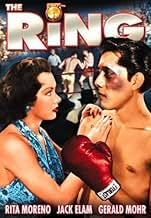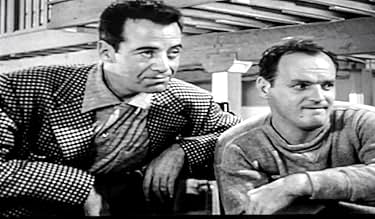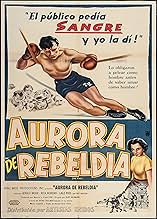Füge eine Handlung in deiner Sprache hinzuA young American of Mexican decent in East Los Angeles, California uses the boxing ring to make a better life for himself and his family, and learns as much about being a Latino in a white s... Alles lesenA young American of Mexican decent in East Los Angeles, California uses the boxing ring to make a better life for himself and his family, and learns as much about being a Latino in a white society as he does about boxing.A young American of Mexican decent in East Los Angeles, California uses the boxing ring to make a better life for himself and his family, and learns as much about being a Latino in a white society as he does about boxing.
Empfohlene Bewertungen
Outstanding overlooked boxing film with an outstanding cast of B actors. Lalo Rios stands out and it seems his fictional boxing career mirrored his real life acting career, in that he showed alot of potential, but for some unexplained reason, never became successful. Filmed on location in early 1950s California in glorious black and white. Very realistic and unromantizied look at boxing and ethnic discrimination. Honestly, I think this film is better then Raging Bull.
Writer Irving Shulman was a talented screenwriter and novelist (including the classic "The Amboy Dukes"), and this is an adequate if cliched boxing story of his. Lead actor Lalo Rios is weak as a young Mexican-American in Los Angeles who learns the hard way that boxing is not such an attractive ticket to the American dream, but Rita as his girlfriend steals the show.
Sure, her part is underwritten, but what beauty from an iconic talent still going strong 72 years later! Director Kurt Neumann does a workmanlike job, obviously not on the level of his sci-fi and fantasy classics like "Kronos", "The Fly" and "She Devil".
Sticking out here is a memorable early scene where Rita takes our hero out to a movie but they're turned away at the box office, pointing to the sign that lists "Colored Night" and "Mexican Night" for segregation -it's not their night!
Sure, her part is underwritten, but what beauty from an iconic talent still going strong 72 years later! Director Kurt Neumann does a workmanlike job, obviously not on the level of his sci-fi and fantasy classics like "Kronos", "The Fly" and "She Devil".
Sticking out here is a memorable early scene where Rita takes our hero out to a movie but they're turned away at the box office, pointing to the sign that lists "Colored Night" and "Mexican Night" for segregation -it's not their night!
East LA local Lalo Rios has a quick temper and quick hands. When a fight promotor (Gerald Mohr) gets him out of a street scrap arrest he takes him on as a boxer, much to his proud father's chagrin. Things start out rosy as "Kid Kansas" wins his first three fights. The undisciplined Rios soon goes diva as his skills dull and his beatings increase.
The Ring is a sincere little effort that shows brief flourishes of style but is unable to go the distance or rank with the heavyweights of the genre. There are split second shots that evoke Raging Bull and Mohr's manager is a switch from the usual exploitive orgre to down to earth realist but Lalo Rios's pugnacious Tomas is a flat lead unable to go the distance.
The film's most notable feature is the injection of institutional racism that culminates in a Beverly Hills restaurant scene which not only comments on race but status as well. Neither champ or tomato can The Ring is a game low-budget effort.
The Ring is a sincere little effort that shows brief flourishes of style but is unable to go the distance or rank with the heavyweights of the genre. There are split second shots that evoke Raging Bull and Mohr's manager is a switch from the usual exploitive orgre to down to earth realist but Lalo Rios's pugnacious Tomas is a flat lead unable to go the distance.
The film's most notable feature is the injection of institutional racism that culminates in a Beverly Hills restaurant scene which not only comments on race but status as well. Neither champ or tomato can The Ring is a game low-budget effort.
This film was presented on TCM during Hispanic Heritage month as a companion piece to "The Lawless". Both works deal with anti Mexican- American prejudice in California in the 50s and feature the work of one of the few non stereotyped Latinx actors in Hollywood at the time, Lalo Rios. And while "The Lawless" is the more famous and heralded of the two, with a bigger budget and a more artistically significant director, I preferred this unabashed B movie about a Los Angeles barrio kid trying to box his way out, with its low budget, crude immediacy, to Joseph Losey's more polished work that mostly focuses on the effect of racism on Anglo liberals.
Are there flaws? You betcha. As in most inexpensive, indie type movies the acting can be problematical. It is especially shocking to see Rita Moreno as a typical ingenue with a very limited emotional range. Obviously Kurt Neumann was not the director to see and extract her future talent. Rios is considerably better although he will never be confused with Robert Ryan in "The Set Up" or even Mickey Rooney in "Killer McCoy", for that matter, to take just two other 50s boxing flics. I also noticed a tendency, in Irving Shulman's screenplay from his novel, for the dialogue to be more stiff and declamatory when the Mexican American characters are speaking to each other than when the Anglos are conversing. Can't say I liked this tendency very much.
Making up for the above lapses, however, are well staged fight scenes as well as tense, powerful examples of discrimination directed by the white denizens of LA toward the brown skinned. The scene set in the Beverly Hills coffee/soda shop, for me at least, had much more of an impact than any number of riots and attempted lynchings, a-la "Lawless".
Bottom line: As is often the case in Tinseltown the B picture is mightier than the A. Give it a B plus.
Are there flaws? You betcha. As in most inexpensive, indie type movies the acting can be problematical. It is especially shocking to see Rita Moreno as a typical ingenue with a very limited emotional range. Obviously Kurt Neumann was not the director to see and extract her future talent. Rios is considerably better although he will never be confused with Robert Ryan in "The Set Up" or even Mickey Rooney in "Killer McCoy", for that matter, to take just two other 50s boxing flics. I also noticed a tendency, in Irving Shulman's screenplay from his novel, for the dialogue to be more stiff and declamatory when the Mexican American characters are speaking to each other than when the Anglos are conversing. Can't say I liked this tendency very much.
Making up for the above lapses, however, are well staged fight scenes as well as tense, powerful examples of discrimination directed by the white denizens of LA toward the brown skinned. The scene set in the Beverly Hills coffee/soda shop, for me at least, had much more of an impact than any number of riots and attempted lynchings, a-la "Lawless".
Bottom line: As is often the case in Tinseltown the B picture is mightier than the A. Give it a B plus.
While obviously made as a "B" feature in its day, "The Ring" is a surprisingly good little flick deserving of far better than the relatively low rating (a 5.6 as I write this) it is currently receiving here on the IMDb.
"The Ring" starts off as a typical boxing "rags to riches" story. A young kid gets into a street fight just as a boxing manager happens to be passing by. Liking what he sees, the manager vows to turn the fiery youngster into a star.
Halfway through the film, however, the "rags to riches" storyline begins to turn and a much deeper side is revealed. More than a decade before the civil rights movement became a large issue in American society, "The Ring" tackled head-on topics such as stereotypes and racial discrimination.
The issues raised are still very relevant today, 56 years after this film was made. Are professional sports truly a way out for impoverished minorities? Or just an unobtainable illusion? And is becoming white the only way for minorities to become accepted into our society? (What could be whiter than a ring name of Tommy Kansas?) All this and a young Rita Moreno, too!...as the "girl next door" love interest.
"The Ring" is not a perfect 5 star film, but it was a movie truly ahead of its time. If you give it a try sometime I think you will be pleasantly surprised.
"The Ring" starts off as a typical boxing "rags to riches" story. A young kid gets into a street fight just as a boxing manager happens to be passing by. Liking what he sees, the manager vows to turn the fiery youngster into a star.
Halfway through the film, however, the "rags to riches" storyline begins to turn and a much deeper side is revealed. More than a decade before the civil rights movement became a large issue in American society, "The Ring" tackled head-on topics such as stereotypes and racial discrimination.
The issues raised are still very relevant today, 56 years after this film was made. Are professional sports truly a way out for impoverished minorities? Or just an unobtainable illusion? And is becoming white the only way for minorities to become accepted into our society? (What could be whiter than a ring name of Tommy Kansas?) All this and a young Rita Moreno, too!...as the "girl next door" love interest.
"The Ring" is not a perfect 5 star film, but it was a movie truly ahead of its time. If you give it a try sometime I think you will be pleasantly surprised.
Wusstest du schon
- WissenswertesRobert Altuna received an "Introducing" credit.
- PatzerBefore the final boxing match; real film footage of Art Aragon is clipped into the fight. His three corner men in the real footage are clearly completely different from the actors playing his corner men in the movie.
- VerbindungenReferenced in Crisis in Morality (1962)
Top-Auswahl
Melde dich zum Bewerten an und greife auf die Watchlist für personalisierte Empfehlungen zu.
Details
- Erscheinungsdatum
- Herkunftsland
- Sprachen
- Auch bekannt als
- Pachuco
- Drehorte
- Produktionsfirma
- Weitere beteiligte Unternehmen bei IMDbPro anzeigen
- Laufzeit
- 1 Std. 19 Min.(79 min)
- Farbe
- Seitenverhältnis
- 1.37 : 1
Zu dieser Seite beitragen
Bearbeitung vorschlagen oder fehlenden Inhalt hinzufügen


























